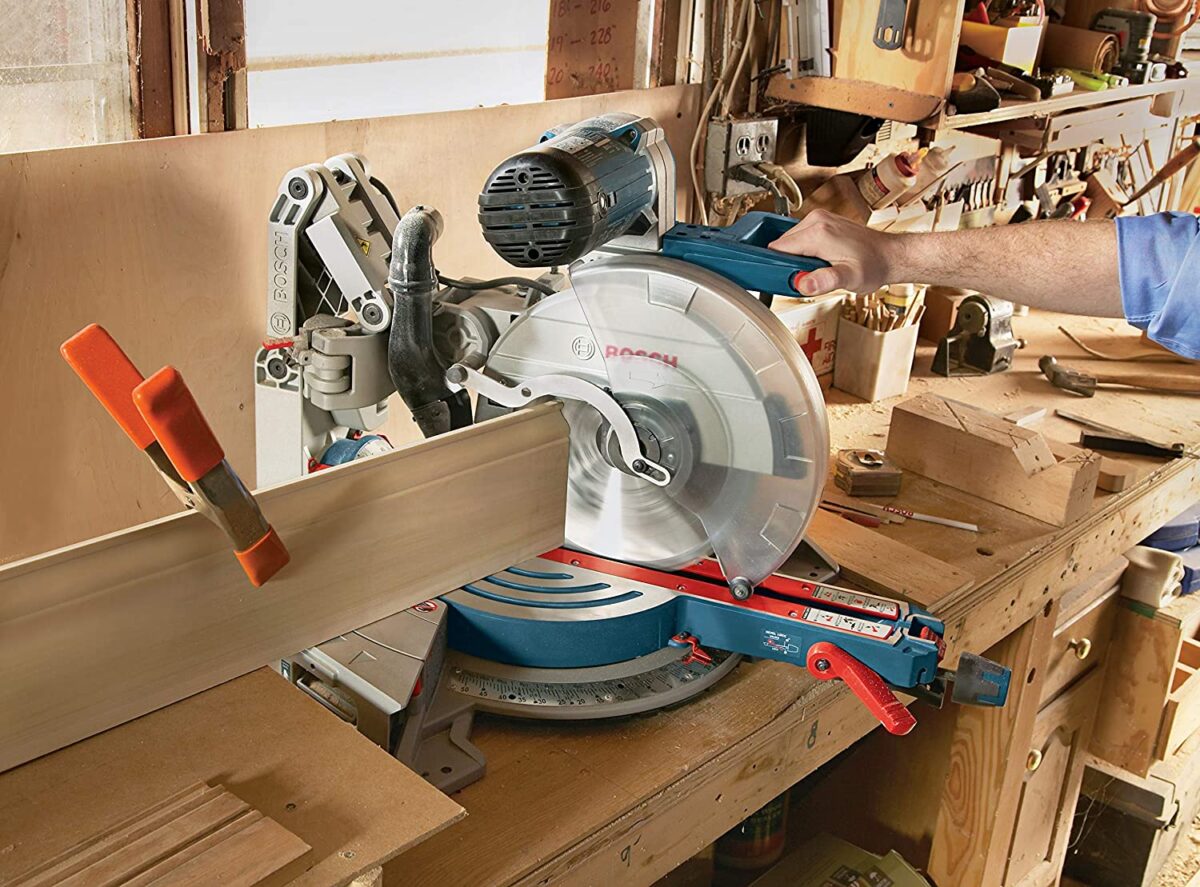
The Best Miter Saw
This Old House Reviews Team
Miter saws are specialty woodworking tools that can make quick and precise cuts to a variety of materials, including crown molding, picture frames, and baseboards. While miter saws are effective at delivering accurate crosscuts, their value over traditional circular saws is their ability to make angled and beveled cuts with ease, a product of their stationary design and up-and-down blade movement.
Miter saws are typically easy to use, and many models are equipped with features like adjustable bevel stops and increased vertical capacities that help users make adjustments and accommodate wood of various sizes. To help you select a miter saw with the accessories and features your DIY woodworking project requires, the This Old House Reviews team researched the best miter saws on Amazon. Here are our top picks.
- Best sliding miter: DEWALT 12-Inch Miter Saw
- Best value: Metabo HPT Compound Miter Saw
- Most versatile: Bosch Sliding Glide Miter Saw
- Best cross-cutting saw: Delta Sliding Compound Miter Saw
- Best accessories: SKIL12-Inch Compound Miter Saw
https://www.amazon.com/dp/B01ESCU5WS
DEWALT 12-Inch Miter Saw
Pros
- Offers dual-beveled blade angling, which allows you to cut bevels on both the left and right side of the material
- Equipped with a miter handle for quick and easy lock adjustments
Cons
- Doesn’t come with an LED or laser cutting guide
- Some customers complained about the product’s 56-pound weight
https://www.amazon.com/dp/B07PX44JQM
Metabo HPT Compound Miter Saw
Pros
- Equipped with a horizontal handle for a comfortable and secure hold
- Offers an angle range between 0–52 degrees
- Contains a vice clamping system that secures cutting material
Cons
- Its bevel only adjusts to the left
- Many customers expressed concern over the flimsy metal used for the saw’s base
https://www.amazon.com/dp/B004323NNC
Bosch Sliding Glide Miter Saw
Pros
- Equipped with a bevel lock at the front of the saw to prevent the need to reach behind the saw blade
- Its dust chute has a vacuum adapter for efficiently removing sawdust
- Contains a soft-grip handle for increased comfort during use
Cons
- Expensive compared to other top-rated miter saws
- Doesn’t come with a laser guide
https://www.amazon.com/dp/B07V8VL3MH
Delta Sliding Compound Miter Saw
Pros
- Provides seven bevel stops at the most popular cutting angles
- Built with an aluminum frame for increased durability
Cons
- Only supports a 10-inch blade
https://www.amazon.com/dp/B00FN7JQZ0
SKIL12-Inch Compound Miter Saw
Pros
- Has nine positive stops for setting commonly cut angles
- Equipped with a left and right table extension for accommodating longer workpieces
- Contains a quick-mount system for a simple set-up on a SKIL miter saw stand, sold separately
Cons
- Is a single-bevel saw, meaning it only bevels in one direction
- Some customers said that the included angle stops weren’t precise, resulting in inaccurate cuts
Buyer’s Guide
When purchasing a miter saw, consider the model’s cut type, size, and dust collection.
1. Cut type
Cut type refers to how the miter saw can cut a piece of wood. The three most popular cuts are crosscuts, miter (angled) cuts, and bevel cuts. Crosscuts are basic cuts that run parallel to the workpiece’s sides. Miter cuts are angled cuts that slice the workpiece at an angle. The most common miter cut is at a 45-degree angle and is used to seat two corners of wood together.
Beveled cuts are angled cuts that cut into the thickness of the wood rather than its width. Beveled cuts are generally used to create an appealing finish to the end of the wood, seen when two baseboards meet at a corner.
2. Size
The size of a miter saw is determined by the size of the blade it can hold. The blade size you’ll need depends on the width of your workpiece. If you work with thicker wood, you may want to purchase a 12-inch miter saw with a larger blade size.
3. Dust collection
Investing in a miter saw with a dust collection function keeps your workspace clean and prevents irritation during operation. Nearly all miter saws are equipped with a dust bag that collects sawdust, though some models offer hose ports that allow you to connect a vacuum cleaner for additional dust management.
FAQs
What’s the difference between a chop saw and miter saw?
A chop saw is a useful power tool for making crosscuts, as its blade can only move up and down at a 90-degree angle. Miter saws are equipped with adjustable blades that can make beveled and angled cuts to suit a variety of woodworking needs.
Can a miter saw cut through metal?
Yes. To cut metal with a miter saw, ensure that your tool is equipped with the proper metal-cutting blade, and make sure that you’re cutting at a low enough RPM to prevent excessive sparking and burnout.
Are miter saws safe?
As with any power tool, operating a miter saw comes with some risks. However, if you follow the proper precautions during use, you can prevent an accident from occurring. When operating a miter saw, wear protective eye goggles and earplugs to prevent damage to your eyes and ears. Additionally, use any included safety clamps and blade guards while operating the machine to prevent an accidental laceration.
The This Old House Reviews team provides overviews of select products that are top-selling on Amazon and/or popular in consumer searches. Our team evaluates the products based on industry research, consumer reviews, pricing data, hands-on testing in select cases, and other objective criteria unique to a given product line. Unless otherwise noted, these product reviews are intended to help inform buying decisions for DIY or other non-pro users only. Editor’s picks are made by members of the Reviews team, and do not imply an endorsement by the experts on This Old House or Ask This Old House.
